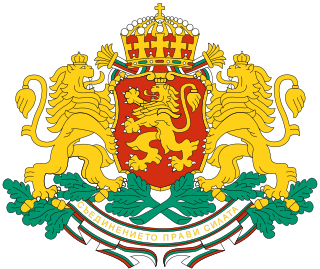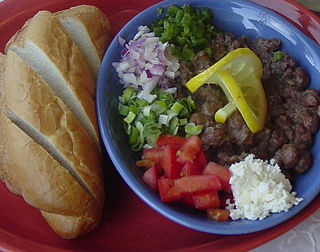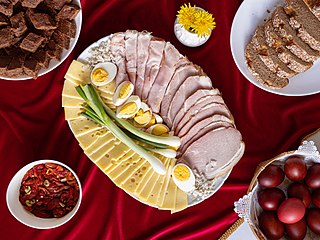
Ethiopian cuisine, which is synonymous with Amhara cultural food, characteristically consists of vegetable and often very spicy meat dishes. This is usually in the form of wat, a thick stew, served on top of injera, a large sourdough flatbread, which is about 50 centimeters in diameter and made out of fermented teff flour. Ethiopians usually eat with their right hands, using pieces of injera to pick up bites of entrées and side dishes.

Greek salad or horiatiki salad is a salad in Greek cuisine generally made with pieces of tomatoes, cucumbers, onion, feta cheese, and olives and dressed with salt, Greek oregano, lemon juice and olive oil. Common additions include green bell pepper or caper berries. Greek salad is often imagined as a farmer's breakfast or lunch, as its ingredients resemble those that a Greek farmer might have on hand.

In Greek cuisine, saganaki is any one of a variety of dishes prepared in a small frying pan, the best-known being an appetizer of fried cheese. It is commonly flambéed in North America.

Bulgarian cuisine is part of the cuisine of Southeast Europe, sharing characteristics with other Balkan cuisines. Bulgarian cooking traditions are diverse because of geographical factors such as climatic conditions suitable for a variety of vegetables, herbs, and fruit. Aside from the variety of local Bulgarian dishes, Bulgarian cuisine shares a number of dishes with its neighboring countries, in particular with Turkish and Greek cuisine.

Shahan ful, simplified to ful, is a dish common in Sudan, South Sudan, Somalia, Ethiopia and other parts of the Horn of Africa, which is generally served for breakfast. Believed to originate from Sudan, it is made by slowly cooking fava beans in water. Once the beans have softened, they are crushed into a coarse paste. It is often served with chopped green onions, tomatoes, and hot green peppers, as well as yogurt, feta cheese, olive oil, tesmi, berbere, lemon juice, cumin, and chili pepper. It is typically eaten without the aid of utensils accompanied with a bread roll. It is popular during the Ramadan season and during the various Lents.

Shakshouka is a Maghrebi dish of eggs poached in a sauce of tomatoes, olive oil, peppers, onion, and garlic, commonly spiced with cumin, paprika and cayenne pepper. Shakshouka is a popular dish throughout North Africa and the Middle East.

Bourdeto is a fish dish from Corfu. It comes from the Venetian word brodetto, which means 'broth'. It is fish cooked with onion, and red sweet and hot spicy pepper. The best fish for bourdeto is scorpion fish. One can also find the same dish containing fillet of a bigger kind of fish. In Patras and western Greece, the dish is also called "bourgeto"/"bourjeto". In Zakynthos meat is used, instead of fish.

Tunisian cuisine, the cuisine of Tunisia, consists of the cooking traditions, ingredients, recipes and techniques developed in Tunisia since antiquity. It is mainly a blend of Mediterranean and native Berber cuisine with Punic influences. Historically, Tunisian cuisine witnessed influence and exchanges with many cultures and nations like Italians, Andalusians, French and Arabs.

Many cuisines feature eggplant salads and appetizers.

Pizza arrived in the United States in the early 20th century along with waves of Italian immigrants who settled primarily in the larger cities of the Northeast, such as New York, Philadelphia, Boston and Baltimore. After American soldiers stationed in Italy returned from World War II, pizza and pizzerias rapidly grew in popularity.

Macaroni cheese pie is a pie dish based on baked macaroni and cheese. Primary ingredients may include elbow macaroni, cheese, and milk.

Ema datshi is a spicy Bhutanese stew made from hot chili peppers and cheese. It is among the most famous dishes in Bhutanese cuisine, recognized as the national dish of the country. Over the years, ema datshi, which has its roots in Tibetan culinary traditions, has undergone various changes to suit with the preference of local Bhutanese taste.

A meatball is ground meat (mince) rolled into a ball, sometimes along with other ingredients, such as bread crumbs, minced onion, eggs, butter, and seasoning. Meatballs are cooked by frying, baking, steaming, or braising in sauce. There are many types of meatballs using different types of meats and spices. The term is sometimes extended to meatless versions based on legumes, vegetables, mushrooms, fish or other seafood.

Kung Pao chicken, also transcribed Gong Bao or Kung Po, is a spicy, stir-fried Chinese dish made with cubes of chicken, peanuts, vegetables and chili peppers and Sichuan peppercorns. From its origins in Sichuan cuisine, the dish's popularity has spread throughout China, spawning a number of regional variations some of which are less spicy than the classic version.

Balkan cuisine is a type of regional cuisine that combines characteristics of European cuisine with some of those from West Asia. It is found in the Balkan Peninsula of Southeast Europe, a region without clear boundaries but which is generally considered to at least include the modern countries of Albania, Bulgaria, Turkey, Romania and Greece and the former Yugoslavia, with the possible exception of Slovenia and northern inland regions of Croatia.
TikTok food trends are specific food recipes and food-related fads on the social media platform TikTok. This content amassed popularity in 2020 during the COVID-19 pandemic, as many people cooked and ate at home and more people turned to social media for entertainment. While some TikTok users share their diets and recipes, others expand their brand or image on TikTok through step-by-step videos of easy and popular recipes. Users often refer to food-related content as "FoodTok."














